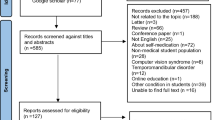Abstract
Methods
The possible association of brain tumour with headache was investigated in 100 patients seen for brain surgery. Preoperatively, 43 patients suffered from headache. These patients were thoroughly questioned about the nature of their pain. Investigation included the McGill Pain Questionnaire.
Results
In only 11 of the patients was headache the primary symptom of a brain tumour. Pain intensity was found to be lower in patients with brain tumour then in those with extracranial tumours or headache of other origins. Female subjects, patients under 50 years of age and those with elevated intracranial pressure experienced more intensive pain. Diurnal variation in pain intensity was observed in 60% of patients with headache. There was no evidence, however, of an association with elevated intracranial pressure.
Conclusions
Our investigations yielded new information concerning the epidemology of headache accompanying brain tumours. Headache is not an early cardinal symptom of brain tumours, as was generally believed earlier. With the help of the McGill Pain Questionnaire a fine quantitative and qualitative characterization of headache of different origins could be made. The connection between tumour localization and pain lateralization, as well as the possible mechanisms of intracranial pain projection was extensively analysed. The interpretations of the results are at best hypotheses and they do not help determine why more than half of the patients with brain tumour did not experience headache.
Zusammenfassung
Der Zusammenhang zwischen Hirntumor und Kopfschmerz wurde bei 100 Patienten präoperativ untersucht. Kopfschmerzen führten die Patienten nur in 11 Fällen zum Arzt. Zum Zeitpunkt der Untersuchung klagten 43 Patienten über Kopfschmerzen. Bei ihnen wurde eine detaillierte Schmerzanamnese, inklusive eines McGill Pain Questionnaire, erhoben. Die Intensität der Schmerzen war bei diesem Patientengut niedriger als bei Patienten mit extrakraniellen Tumoren oder Kopfschmerzen anderer Genese. Frauen, Patienten unter 50 Jahre und Patienten mit erhöhtem Hirndruck hatten stärkere Schmerzen. Eine tageszeitabhängige Schmerzintensitätsänderung bestand bei 60% der Kopfschmerzpatienten ohne Zusammenhang mit dem Vorhandensein eines erhöhten intrakraniellen Druckes. Die Zusammenhänge zwischen Tumorlokalisation und Schmerzlateralisation sowie die möglichen Mechanismen der intrakraniellen Schmerzprojektion wurden eingehend analysiert. Eine Interpretation der erhobenen Befunde ist schwer und von hypothetischer Natur. Die Frage, warum über die Hälfte der Patienten mit Hirntumor keine Schmerzen empfand, bleibt weiterhin unbeantwortet.
Similar content being viewed by others
Literatur
Agnew DC, Merskey H (1976) Words of chronic pain. Pain 2: 73
Blakeslee TR (1980) The right brain. Anchor Doubleday, Garden City
Bonica JJ (1990) Cancer pain. In: Bonica JJ (ed) The management of pain. Lea & Febiger, Philadelphia, p 400
Bonica JJ (1990) Pain caused by cancer of the head and neck and other specific syndromes. In: Bonica JJ (ed) The management of pain, Lea & Febiger, Philadelphia, p 793
Campbell JA, Lahuerta J, Bowsher D (1985) Pain laterality in relation to site of pain and diagnosis. Pain 23: 61
Chen ACN (1993) Human brain measures of clinical pain: a review I. Topographic mappings. Pain 54: 115
Chen ACN (1993) Human brain measures of clinical pain: a review II. Tomographic imagings. Pain 54: 133
Childhood Brain Tumor Consortium (1991) The epidemiology of headache among children with brain tumor. J Neurooncol 10: 31
Csanda E, Jelencsik K, Gáspár L (1985) Headache and intracranial pressure. Cephalalgia 5 [Suppl 3]: 294
Dalessio DJ (1980) Pain-sensitive structures within the cranium. In: Wolf HG (ed) Headache and other head pain, 4th edn. Oxford University Press, Oxford, p 24
Dalessio DJ (1989) Headache. In: Wall PD, Melzack R (eds) Textbook of pain. Churchill Livingstone, Edinburgh, p 386
DeBenedittis G, DeGonda F (1985) Hemispheric specialisation and the perception of pain: a task related EEG power spectrum analysis in chronic pain patients. Pain 22: 375
Folkhard S, Glynn CJ, Lloyd JW (1976) Diurnal variation and individual differences in the perception of intractable pain. J Psychosom Res 20: 289
Hall W, Hayward L, Chapman CR (1981) On the “lateralisation of pain”. Pain 10: 337
Hall W, Clarke IMC (1982) Pain laterality in a British pain clinic sample. Pain 14: 63
Harkins SW, Kwentus J, Price DD (1990) Pain and suffering in the elderly. In: Bonica JJ (ed) The management of pain. Lea & Febiger, Philadelphia, p 552
Hunter M (1983) The headache scala: A new approach to the assessment of headache pain based on pain description. Pain 16: 361
Janzen R (1969) Elemente der Neurologie. Springer, Berlin Heidelberg New York, S 101
Kiss I (1987) Karzinomschmerzen. Springer, Berlin Heidelberg New York
Kiss I, Müller H, Abel M (1987) The McGill Pain Questionnaire—German version. A study on cancer pain. Pain 29: 195
Kunkle EC, Ray BS, Wolff HG (1942, 1943) cited by Dalessio DJ (1989) Headache. In: Wall PD, Melzack R (eds) Textbook of pain. Churchill Livingstone, Edinburgh, p 386
Margolis RB, Krause SJ, Tait RC (1985) Lateralization of chronic pain. Pain 23: 289
Melzack R (1975) The McGill Pain Questionnaire: Major properties and scoring methods. Pain 1: 277
Melzack R (1983) The measurement of pain experience. In: Lipton S, Miles J (eds) Persistent pain, vol 4. Grune & Stratton, London, p 173
Merskey H, Watson GD (1979) The lateralization of pain. Pain 7: 271
Pollen JJ, Schmidt JD (1979) Bone pain in metastatic cancer of prostate. Urology 13: 129
Popper KR, Eccles JC (1977) The self and its brain. Springer, Berlin Heidelberg New York
Ray BS, Wolf HG (1940) Experimental studies on headache: Pain sensitive structures of the head and their significance in headache. Arch Surg 41: 813
Ruda MA (1993) Gender and pain. Pain 53: 1
Rushton JG, Rooke ED (1962) Brain tumor headache. Headache 2: 147
Springer SP, Deutsch G (1987) Linkes, rechtes Gehirn. Funktionelle Asymmetrien. Spektrum, Heidelberg
White JC, Sweet WH (1969) cited by Merskey H, Watson GD (1979) The lateralization of pain. Pain 7: 271
Author information
Authors and Affiliations
Rights and permissions
About this article
Cite this article
Kiss, I., Franz, M. & Kilian, M. Hirntumor und Kopfschmerz. Schmerz 8, 183–189 (1994). https://doi.org/10.1007/BF02530396
Received:
Accepted:
Issue Date:
DOI: https://doi.org/10.1007/BF02530396




